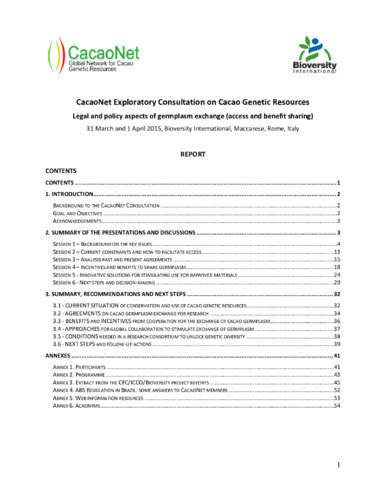CacaoNet Exploratory Consultation on Cacao Genetic Resources: legal and policy aspects of germplasm exchange (access and benefit sharing). 31 March and 1 April 2015
There are 2 international cacao collections, one maintained at CATIE in Costa Rica and the other at the Cocoa Research Centre (CRC) in Trinidad and Tobago. The materials in the collections have been included under Article 15 of the International Treaty on Plant Genetic Resources for Food and Agriculture (ITPGRFA) through a formal agreement signed in 2006 for CATIE and 2009 for CRC. The germplasm is distributed with an accompanying Standard Material Transfer Agreement (SMTA) (template from of the ITPGRFA. The SMTA includes an Access and Benefit-Sharing (ABS) agreement for the distribution and receipt of germplasm.
In addition to the 2 collections maintained at CATIE and CRC, the International Cocoa Quarantine Centre, Reading (ICQCR), UK ensures the safe movement of cacao germplasm between countries and regions. The materials maintained at the ICQCR mainly come from the 2 international collections but they also can manage materials provided to them by a national programme.
The rest of cacao genetic diversity is maintained in national collections and farmers’ fields and in the wild, and is therefore outside the scope of the ITPGRFA because cacao is not an Annex 1 crop, which by definition is within the scope of the Convention on Biological Diversity (CBD) and the Nagoya Protocol and bilateral agreements. The FAO Commission on Genetic Resources for Food and Agriculture (CGRFA), including plants, animal, microbial and forests, is the overarching inter-governmental body discussing all aspects of genetic resources for food and agriculture.
The work of Bioversity International over the years in this area can provide guidance. It was therefore suggested that CacaoNet and Bioversity organise an exploratory consultation on cacao genetic resources access and benefit sharing policies and agreements, which took place in Rome 31 March and 1 April 2015.

